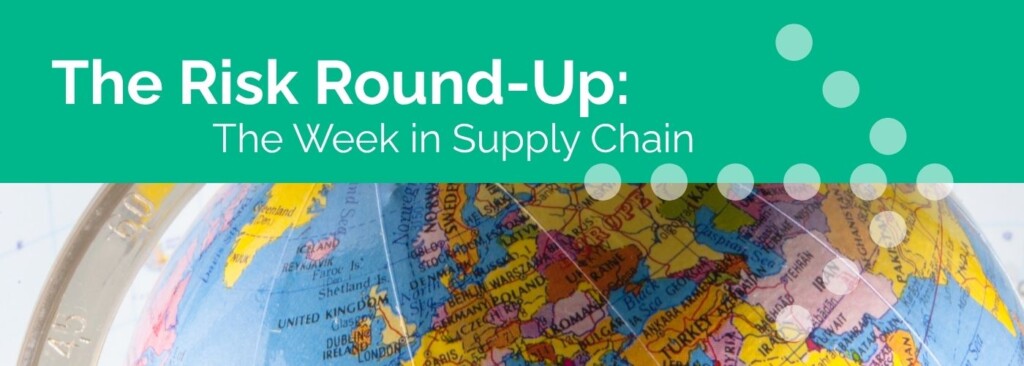
This week’s supply chain risk news
Three risk scenarios for the Middle East
Six weeks into a ceasefire deal between Israel and Hamas, tensions are high. Each side accuses the other of violating their agreement. Plus, the Rafah Border Crossing between Egypt and Gaza remains closed. It’s not clear what the next phase of peace negotiations might look like, or when it might begin. In our Risk Center, we detail three potential security scenarios:
- The ceasefire deal could break down with fighting potentially spilling into a broader conflict. Cross-border missile strikes have repeatedly disrupted area businesses and logistics before. More fighting could also strain Israel’s economic and diplomatic relationships abroad.
- Provided that doesn’t happen, things will likely stay tense until the next phase of the peace process is decided. Israel has sometimes fired on alleged Hezbollah targets in Lebanon. Such intermittent strikes can disrupt air and ocean freight movement, and potentially shipping through the Suez Canal.
- If the ceasefire holds and new phases of the peace deal can progress, then the security situation might resemble a time before October 2023. Such a stabilization, while far from perfect, would be a meaningful improvement–and not just for businesses and supply chains.
An unslakable thirst for power
The parts that make up the U.S. power grid are in high demand—and in short supply. Equipment like transformers, circuit breakers, cables, and steel poles all take time to produce, the Conversation reports. Additionally, “supply-chain bottlenecks are taking years to clear, delaying projects, inflating costs and threatening reliability.”
The challenge is daunting for a few reasons. One is that tens of millions of high-voltage distribution transformers in the country are close to or past their expected lifespans and will soon need replacements. Another factor is the ever-growing demand of data centers due to AI. Two facilities in Silicon Valley may stand empty for years for want of power.
The U.S. has long imported most of its large transformers from Mexico, China, and Thailand, though that’s also more challenging. Copper and steel aren’t getting easier to acquire, either.
Remarkably, one approach utilities have taken to this problem is to stockpile spare transformers. Although the Department of Energy has noted many “are stored under less-than-ideal conditions.” If you’re worried something bad might happen to your substation, the lesson seems, you might not want to leave your replacement parts in places vulnerable to the same risks.
Frenemies until the end?
Earlier this year, China dialed back exports of the rare earths. These are used in everything from cars to wind turbines to advanced weapons technologies. Amid negotiations with the U.S. over tariffs, the message seemed to be: Don’t overstep. You depend on us.
Beyond rare earths, indeed, the same might be said of a U.S. reliance on China for pharmaceuticals, electrical equipment, lithium batteries, and a host of other goods. That’s one upshot from a new report to Congress out this week from the U.S.-China Economic and Security Review Commission.
Among its many recommendations, the report refers to active pharmaceutical ingredients (APIs) and key starting materials (KSMs). It urges Congress “to require drug manufacturers to report volume and ultimate origin of APIs and KSMs used in drugs consumed in the United States, including sourcing of Chinese content through third countries.” Another recommendation would require utilities “to identify all Chinese-origin components within their high- and medium-impact bulk electric system and protected cyber assets.”
For China’s part, experts reportedly dismissed the findings as biased, arguing the 745-page report “unfairly portrays China’s normal economic activities as a threat.”
Work in procurement? Knowing people in logistics might make your life better
For many manufacturers, raw materials and parts can make up more than half of a product’s total cost. But getting a deal on those goods is less valuable if they’re lost, delayed, or damaged en route to you. This is why partnerships between procurement and logistics teams are key.
Fortunately, it’s easy to get started by inviting your logistics counterparts to share their data in quarterly business reviews with important suppliers. This lets you and your suppliers work from the same facts. Next, it helps to build a shared dashboard of your overlapping goals, rather than examining procurement and logistics metrics separately.
Your logistics team can also help evaluate new suppliers. How do transit times, risks, and total landed costs compare? This can help you select a supplier with not just price but resilience in mind. Here, risk monitoring can help teams better assess both procurement risks – like factory fires, cyber-attacks, and labor strikes – and threats to timely delivery like storms and port strikes.
Procurement pros getting the goods they need in time hinges on logistics. We discuss the opportunity this presents more in our blog.
Other stories we’re reading and monitoring
In Mexico, thousands of people have taken to the streets and sometimes clashed with police during protests demanding better security and answers to systemic corruption.
India’s goods exports to the U.S. jumped 14.5 percent in October. This is the first increase in five months – even as steep tariffs remain in place amid ongoing negotiations.
The U.S. and its allies would love to rely less on China for rare earths, but they may have a hard time sourcing the elements that keep magnets, well, magnetic at high temperatures.
The wrangling over Nexperia continues. The Netherlands has taken a step back from seizing the chip maker and China called the move a “step in the right direction.” For carmakers, the disruption to supply chains remains a headache.



